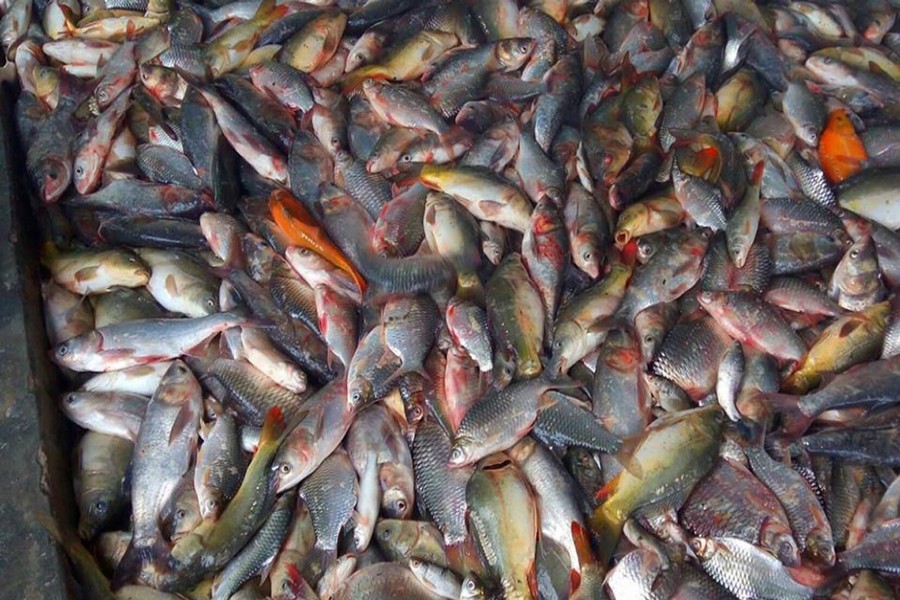Few in the country could think of the present hilsa bonanza beforeit tentatively started making its spectacular comeback. The fish's reappearance began only a few years ago. Thanks to the present 22-day annual ban on hilsa catching enforced by the government, the country in the recent years could claim for itself the status of being self-sufficient in hilsa. At the moment, the nation looks forward to full-scale of export of hilsa. This year, fish markets in the country experienced buyers finding the 'national fish' affordable. Even in the immediate past, they sold at prohibitive prices.
Lately, a different piece of good news has started making the rounds in different parts of the country. Almost like that related to hilsa, it comprises an impressive reappearance of native fishes --- a vast number of them long declared extinct. In the recent months, markets in Dhaka and the other cities have become used to a different scenario. The spectacle has fish-lovers throng sellers' points to purchase new arrivals of 'deshi' fishes of medium to smaller sizes.
These fresh-water fishes once filled the country's rivers, 'haors', 'beels' and other water bodies. They would be found round the year. The seemingly 'aristocratic' hilsa remains in their habitats for a short period. In the past, the local fishes used to be found in their every conceivable source throughout the year. They played a great role in meeting the protein requirements of vast numbers of the rural people in the country.
Thanks to the myriad types of adverse conditions, these fish populations at one point of time began experiencing a declining trend. The murky developments eventually reached a highly dismal point. It became clear when the names of many traditional local fishes sounded strange even to the village teenagers and youths. Due to the relentless scientific research conducted by the government fish research institutes, these long forgotten names of native fishes once again found a major place in the list of the country's fish species. According to Bangladesh Fisheries Research Institute (BFRI) in Mymensingh, there are 260 species of fresh-water fish in Bangladesh at present. Of them, 64 species are endangered. According to fishing communities, a lot of other fishes have long gone extinct.
Reviving various extinct fish and sea species from eggs and DNA samples is nowadays a common practice among marine biologists. It is seen being successfully carried out in many parts of the developed world. Perhaps following suit, the BFRI scientists have proved their remarkable success in inventing the related technology and process to bring 23 endangered fish species back to the country's water bodies --- especially rivers and canals. It makes fish lovers optimistic about the prospects lurking in the research efforts. The BFRI researchers hope by using their technologies, fishermen can now save many long-vulnerable fish species. The outcome has already started becoming evident. It can be gleaned from the crowds around fish retailers selling long-forgotten local fishes. A prominently positive sign regarding the emerging small and mid-size fish trade could be seen on the increase in their demand. In conformity with the demand, the availability of the endangered fishes keeps rising. According to a statistics, small fishes comprise a considerable segment in the country's total fish production. As it has shown, of the 260 species of total freshwater fishes now available in the country, 143 are smaller ones.
Many field studies show the fish-eating people in general in the country prefer smaller, obscure fishes to the larger ones. Even in the cities, a section of consumers normally opt for small-size fishes. They strictly abide by the suggestions of the nutritionists that small fishes contain a number of valuable food ingredients not found in the popular and delicious large fishes. The village markets remain mainly filled with small fresh-water fishes. These local fishes once were abundant in the country's rivers, canals and all types of water bodies --- especially in the receding waters during the post-monsoon periods.
With the fast disappearance of these water bodies prompted by reckless grabbing bouts indulged in by encroachers, the small fish populations entered their first phase of vanishing. Earth-filling of water bodies eventually became a common practice in the country's rural areas. Notwithstanding the purpose being the expansion of agro-plots, few of the people were found being sensitised to the bitter truth --- the squeezing of areas for culturing small fishes. The practice continues unabated in the country's rural areas.
Thanks to the radical role played by BFRI in bringing back 23 endangered native fish species, the country now has 400 hatcheries breeding small indigenous fishes.But still, this development highlights the fact that the contribution of the small fishes to the total fish production ranges from 30 per cent to 35 per cent in the country. This reality continues to become grimmer by the day. Of late, the small native fish scenario has been aggravated by the contamination of water bodies by pesticides, chemical fertilisers and many other toxic substances. Thanks to the degradation of water quality by these agents, the country's long-favourite fishes had at one stage started becoming rarer as time wore on. Lately, seeing these small fishes back in the kitchen market many feel confident of resisting the wholesaledisappearance of the country's native fishes. According to a large section of experts, trade in small fishes significantly contributes to the national economy.
On a broader scale, the share of the fisheries sector in the nation's GDP comes to 3.61 per cent. The small species comprise a large segment in this tally.Like in the BFRI in Mymensingh, the country's other research centres are also engaged in saving the endangered small fishes. The imperative is continued financial support from the fisheries authorities, as well as enforcement of laws for creating undisturbed enclosures for local small fishes.


